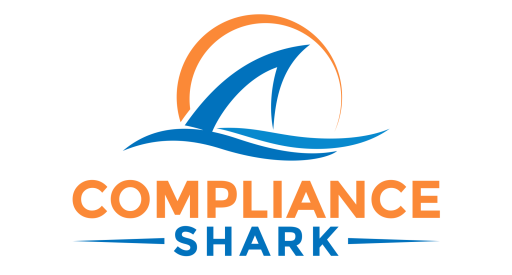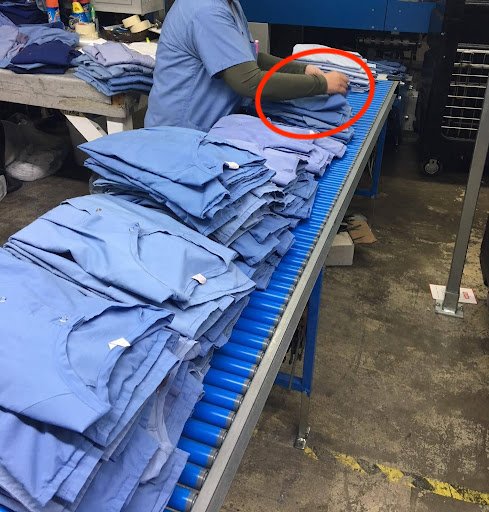Healthcare Textiles: "Dress for Success, Not Contamination: Shielding Healthcare Linens"
Figure 1: Is my Uniform Contaminating This Linen?
Figure 2: Is my Uniform Contaminating this Sheet?
A Contamination Mystery:
Before founding Compliance Shark, I owned and operated a large full service accredited healthcare laundry for 17 years. As part of our process monitoring protocol, we would test linens for contamination at various steps in the laundering process. On one occasion long ago, the linens ready to be sent to customers kept testing positive for contamination. We checked the washers and wash formulas. All were ok. We checked the dryers for contamination. All ok. We checked the clean carts and tables for contamination that could be touching the linen. All ok. But the linen kept testing positive for contamination. What the heck was causing this? One of our brilliant engineers suggested that we test the uniform of the operator moving the linens from the clean linen bin to the table. Bingo! His uniform was dirty, and he was contaminating the linens while moving clean linens to the table.
Prompted by this revelation, we began contemplating how many other scenarios might exist where employee-contaminated uniforms were inadvertently affecting the cleanliness of the linen. Ponder this: employees routinely brushing clean linen against their own uniforms is a common occurrence. Picture an operator guiding towels into a piece folder – inevitably, the towels come into contact with their clothing and arms. It's a given.
Extend this scenario to handling larger pieces like sheets fed into an ironer or a large piece feeder. Sheets, blankets, and thermals, being sizable linen items, almost invariably make contact with the operator's uniforms during the process. This holds true when watching videos of these tasks – the linen and the operator's uniforms intersect in some capacity.
Now, shift your thoughts to employees engaged in stacking clean, folded linen onto shelves or clean carts. Consider whether their sleeves or bodies ever make contact with the linen. The reality is undeniable – these instances are bound to occur.
Let's broaden our perspective to the hospital environment where linen is at the center of operations. Staff in the linen room handle clean linen. The question surfaces – are their uniforms consistently clean? Likewise, those responsible for restocking floor linen closets in the hospital using linen from the linen room – can we be sure their uniforms are maintained at the required cleanliness standards? Extend this further to those handling linen in patient rooms or OR suites – do these handlers don clean uniforms as well?
The realization of these everyday occurrences prompts a critical examination of hygiene practices in various settings. It's not just about the linens' journey; it's about the unseen interactions with employee uniforms that could potentially compromise the stringent standards upheld in healthcare facilities.
Upon realizing this challenge, we confronted two possible courses of action:
Attempting to prevent employees from ever making contact between their uniforms and clean linen. However, this approach is impractical and nearly impossible to implement effectively.
The alternative Involved ensuring that the uniforms worn by employees were consistently hygienically clean, ensuring they would not contaminate the linen even if contact occurred. This option, being pragmatic and feasible, resonated with us, prompting our decision to pursue it.
Below are some practices designed to help employees consistently maintain hygienically clean uniforms while handling clean linen, both within the laundry and healthcare settings:
In the laundry setting, it's imperative to provide employees with hygienically clean scrubs or alternative uniforms before they step onto the finish floor for their duties.
When employees leave for breaks or transition to different areas within the plant or healthcare facility, they must either change into fresh uniforms or cover their existing ones to uphold cleanliness standards.
Vigilance is crucial for employees handling clean linen – they should promptly change into fresh uniforms if, at any point, their current attire becomes contaminated.
Establish a protocol of regularly testing for contamination on the uniforms of all staff that handle clean linen at the healthcare facility or the laundry.
As we delve into the complexities of healthcare laundry, let this story be a reminder that the seemingly mundane aspects of the process can harbor profound implications for patient safety. As we have repeated many times, it’s not only about getting the linens clean. It’s about keeping them clean and there are countless dangerous opportunities for linen contamination on the journey from the washer to the patient. The way to protect linens is by following the highest standards of infection prevention at every stop of this process.



